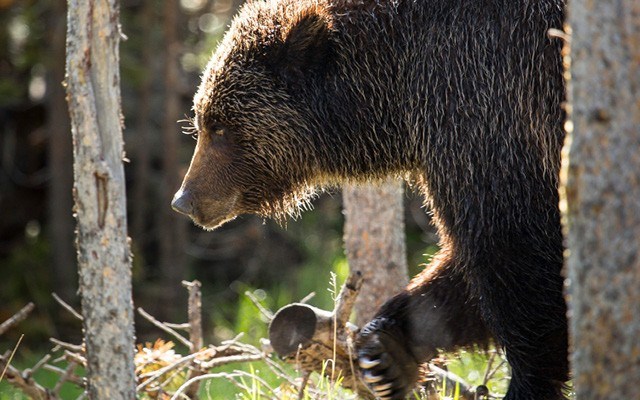When the U.S. Fish and Wildlife Service proposed removing the Yellowstone grizzly population from the Endangered Species list last March, it looked like a decision would finally be made after years of disagreement about the bears' management. But now there's a new twist: Environmentalists say that more information made public in recent weeks about how the states of Wyoming, Montana and Idaho plan to manage grizzlies after the delisting may call into question the long-anticipated ruling.
In a 16-page letter submitted at the end of the comment period in May, and recently made public, the Yellowstone states are pushing for less federal discretion than the proposed rule allowed. Though environmental groups have disagreed with state management before, "we did not expect to see a letter like this," said Tim Preso, an attorney with EarthJustice, one of the organizations behind the successful relisting lawsuit when grizzlies were first given the boot in 2007. "Given the way the states are conducting themselves and their disavowing of key conservation promises — to whatever extent that there was concern about this delisting before, it's certainly been ratcheted up."
The states' proposed revisions go after a number of provisions that could allow the federal government some long-term oversight — perhaps most notably via the Conservation Strategy, the guiding document that replaces the Recovery Plan once a species is delisted. The initial 55-page rule, published on March 11 by the Interior Department, reads: "Consequently, the 2016 Conservation Strategy will remain in effect indefinitely — beyond the five-year post-delisting monitoring period required by the (Endangered Species) Act — to facilitate and assure continued successful management of the population and its habitat across multiple land ownerships and jurisdictions."
In the May letter, states extract this section, arguing against the use of "indefinitely" or "in perpetuity."
"Throughout the proposed rule, there are references to requirements that transcend the ESA's authority and are unduly prescriptive for management of (Yellowstone's grizzlies)," the letter states. "These references are contrary to Congress' delineation between federal authority under the ESA and traditional state wildlife management authority."
The U.S. Fish and Wildlife Service has touted the Conservation Strategy as a landmark achievement that will guarantee the population's sustained long-term recovery after the initial five years. "Now, the states are saying 'Don't count on it,'" Preso said.
Another controversial edit was the states' proposed change from maintaining at least 674 bears, to "between 600 and 747." (The current population estimate is 717.) "That's not what Fish and Wildlife tried to sell the public on," Preso said. "That's not what we all understood."
But since the federal government has in years past said 500 bears is the absolute minimum for population viability, Brian Nesvik, chief game warden for Wyoming Game and Fish, thinks even 600 could be generous. "The way the states view recovery criteria is they establish the floor, and then basically as long as the states continue to exceed or achieve those recovery criteria, the bear population is in good shape. I understand this is very sensitive to folks — folks are very passionate about grizzly bears — but the bottom line is the North American model for wildlife management relies on states to establish management objectives as long as they don't place species in peril. And that's certainly Wyoming's track record."
Many of the states' proposed edits were discussed at the Yellowstone Ecosystem Subcommittee Conservation Strategy Working Meeting in Bozeman, Montana, last week, when federal, state and tribal representatives discussed delisting by November.
As the meeting went on, disagreement among federal and state players quickly emerged. Dan Wenk, superintendent of Yellowstone National Park and one of the few federal officials to express concern about a rapid delisting, questioned where hunting would take place; Wenk advocates for keeping hunting away from the park's boundaries when possible, and directing it toward bear-human conflict zones. The superintendent also asked how bears would be managed in the future if a better population estimator emerged (bears are notoriously difficult to count). In their letter, the states declined to establish rules surrounding hunting seasons prior to delisting.
As a signatory on the Conservation Strategy, the National Park Service hopes such issues will be resolved in the next three to four weeks, but Wenk said he thought a November deadline would still be "very ambitious." Although the final approval of the National Park Service or that of any other signators is not mandatory, a lack of interagency support may give environmental groups more fodder for lawsuits following a delisting.
"(The letter) forces the Fish and Wildlife Service to either push back on the states and say 'No, you have to do these things,' or to try to come up with some reason why the things they initially said were important no longer are," Preso said. "I don't know how they'll justify it."
Gloria Dickie is a former editorial intern for High Country News.




